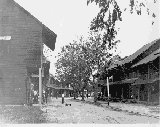![]()
There was no restaurant and chemist's shop. Tawau's center was the padang with sea on one side and whitewashed timber buildings on the other three - the district office, police quarters, the government resthouse, none more then two storeys high. A tower (which still stands at the Town Padang) was erected by the Japanese after World War 1 and hour being rung at intervals by the police guard. The scene was tranquil and beautiful. Traffic was scarce - a handful of private cars, lorries, and vehicles belonging to the estate. From the padang, Dunlop Street turned into Apas Road, which was metalled for 4-5 miles. From its end, a tract went on to the lighthouse at Batu Tinagat; other roads branched off to Kuhara rubber estate and Sin On. There was no ingress from further afield from the landward side. It was a very inhibited area and small and well defined. Its people knew intuitively that they had to live and work together. Despite there were many different races and ethic groups and religious, the town was very peaceful. There was no serious crime; doors and windows of dwelling houses were normally left unlocked.
There was neither electricity supply nor main drainage. The water supply to the town was by means of tubs set on trolleys, which ran along the narrow gauge trolley line from Tawau River. The tubs were hauled by hand. A telephone line linked the District Office with the District Officer's house, the lighthouse and Kuhara estate. The Government's wireless station communicated daily with Sandakan, whence messages were transmitted to Hong Kong and Singapore. There was no bank, but money could be remitted through the post office, and the Treasury accepted and repaid deposits on behalf of the State Bank.

There were 300 Japanese working on the estate and 100 on Si-Amil Island. They owned the biggest estates (Kuhara estate) and a golf course. There was an estate hospital and representative office of a Japanese Bank set up for the benefit of the Japanese inhabitants. Their commercial fishing (mainly tuna) was unique. Their company, Borneo Fishing Company, whose office and factory were mainly worked by Japanese women. The workers and suppliers arrived in Tawau in Japanese ships, and all were disembarked into launchers and lighters and taken direct to Si-Amil. Despite their commercial activities, they left no impact on Tawau in term of local affairs, social and cultural life.
The S.S. Kinabalu of the Sabah Steamship Company linked Tawau with Sandakan, Lahad Datu, Semporna and Tungku (yes, Sabah Steamship, the name 'Sabah' then was already in use and the company was a subsidiary of Chartered Company). The ship was wrecked off Semporna and later replaced by S.S. Baynain by The Bakau Company (also a subsidiary of the Chartered Company). The government cruiser, "Petrel", was based in Tawau. But it was often used on duty elsewhere. Apart from that, there were very few sailing craft. There was no airfield in Tawau (or anywhere in Sabah). There was a small public hospital close to the shore but had no medical officer. A medical doctor by the name of Ernst Sternfeld was sent from Sandakan to station in Tawau in 1939-1940, but lasted only for a few months.
| economy | developments | the government | history | ports | photo gallery | guestbook |
infoTAWAU Online
Copyright © 2000. All rights reserved.
Last updated on 2 December 2000.